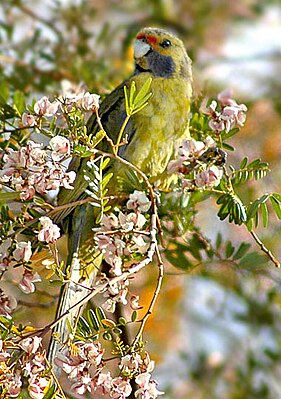Yellow-bellied Parakeet
| Yellow-bellied Parakeet | ||||||||||||
|---|---|---|---|---|---|---|---|---|---|---|---|---|

Yellow-bellied Parakeet eating a flower |
||||||||||||
| Systematics | ||||||||||||
|
||||||||||||
| Scientific name | ||||||||||||
| Platycercus caledonicus | ||||||||||||
| ( Gmelin , 1788) |
The yellow-bellied parakeet ( Platycercus caledonicus ) is the largest species of the flat-tailed parakeet . Yellow-bellied parakeets are of course only found in Tasmania and a large number of islands near the coast. You can find them in Bass Strait on King Island , Deal Island and Dover Island, among others .
The yellow-bellied parakeet was first described as Psittacus caledonicus by the German scientist Johann Friedrich Gmelin in 1788 . The specific epithet is derived from the erroneous belief that the bird hide described was collected on New Caledonia .
Appearance
Yellow-bellied parakeets reach a body length of up to 37 centimeters and weigh between 109 and 142 grams.
The male of the yellow-bellied parakeet has a strong dark yellow head and neck. The ear covers are a bit greener and the back neck is speckled black and green. The striking purple-blue cheek spots are striking. The front back and the umbrella feathers are black with a very narrow greenish border. The back is greenish yellow. The wing crease as well as the outer middle wing covers and the outer arm covers are blue-violet. The hand covers, the hand wings and the arm wings are black-brown. The outer plumes of the feathers have a blue-violet border towards the base. The under wing-coverts are also blue-violet. The underside of the body is bright yellow. The beak is grayish horn-colored. The iris is dark brown.
The females are similar to the males, but their plumage has an orange-red base tone. They also have a slightly smaller build and beak. The significantly narrower upper beak is striking.
Yellow-bellied parakeets are powerful fliers. In flight, rapid wing beats alternate with short gliding phases. Longer distances are also often conquered close to the ground. They are characterized by an upward movement when they land on a branch. In doing so, they fan out the tail and glide towards the target branch without flapping their wings.
habitat
Apart from raised bog areas and treeless agricultural land, the yellow-bellied parakeets colonize all habitats on Tasmania and the adjacent islands. These include savannah and rainforests, heather shrubland, pastureland with loose trees, orchards, parks and gardens. They are basically true-to-place birds.
food
Yellow-bellied parakeets are predominantly herbivores. They prefer to eat the seeds of grass, bushes and trees. The seeds of the eucalyptus trees play a special role. They also eat berries, fruits, flowers, buds and nectar, and to a lesser extent insects and their larvae. They also invade orchards and eat the fruits grown there. Hence, they can do some damage there.
Reproduction
Yellow-bellied parakeets are cave breeders. The breeding season of the yellow-bellied parakeet is from October to January. The courtship and breeding behavior is very similar to that of the Pennant Parakeet . Only one clutch is raised per year. The clutch consists of four to five white and slightly shiny eggs. They measure 30 × 24 millimeters. Fledglings leave the nest box at an age of about five weeks. They form a family group with the adult parent birds for four to five weeks. Then they join other young birds of their kind and form flocks with them, which show a stronger migratory behavior than that of the adult birds.
supporting documents
Individual evidence
- ↑ Sindel, Stan & Gill, James: Australian Broad-tailed Parrots . Surrey Beatty & Sons, Chipping Norton (Sydney) 1999, ISBN 0-9587727-6-2 .
- ^ Forshaw, p. 430 and p. 431
- ^ Forshaw, p. 431
- ^ Forshaw, p. 433
- ↑ G Beruldsen: Australian Birds: Their Nests and Eggs . self, Kenmore Hills, Qld 2003, ISBN 0-646-42798-9 , p. 246.
literature
- Joseph M. Forshaw : Australian Parrots. 1st German-language edition. Volume 2, Arndt-Verlag, Bretten 2003, ISBN 3-9808245-2-7 .
Web links
- Platycercus caledonicus in the Red List of Threatened Species of the IUCN 2013.1. Listed by: BirdLife International, 2012. Retrieved September 28, 2013.
